

Laser pistol
- View history
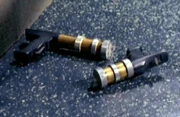
Starfleet laser sidearm (2254)
A laser pistol , or hand laser , was a directed-energy weapon utilized by the Klingon Empire and the United Federation of Planets . ( TOS : " The Cage ", " A Private Little War ")
- 1 Specifications
- 3.1 Appearances
- 3.2 Background information
- 3.3 Apocrypha
Specifications [ ]
The pistols used by Starfleet in the 2250s and 2260s were designed with multiple power settings. For example, they had enough power to blast through rocks and security glass, and to disintegrate Humanoid -size androids . The laser pistol was also capable of being set to overload, resulting in a forced chamber explosion . These weapons were considered "old-style" by the end of the 2260s. ( TOS : " The Cage ", " What Are Little Girls Made Of? ", " A Private Little War ")
History [ ]
The Federation had utilized hand-held laser weaponry for over 100 years , as of 2269 . ( TAS : " The Slaver Weapon ")
In 2254 , after having been kidnapped by the Talosians , Captain Christopher Pike attempted to use laser pistols to blast his way out of his cell , but was distressed to find that the lasers were empty. He correctly deduced, though, that the Talosians had been using their powers of illusion to make Pike believe that the lasers were inoperative, and he had successfully breached the cell he was being kept in. Later, after escaping to the surface, Number One set her laser to overload, informing The Keeper that Humans would rather die than live in captivity. This, combined with information they had assimilated from the USS Enterprise 's historical records, convinced the Talosians that Humans were too unstable to be held against their will. ( TOS : " The Cage ")
In 2261 , laser pistols were standard equipment for the Crater expedition to M-113 , as well as the Korby expedition to Exo III , both of which were outfitted in the same year. The hand lasers were still in use in 2266 . ( TOS : " The Man Trap ", " What Are Little Girls Made Of? ")
In 2265 , Spock and other members of an Enterprise landing party were armed with laser pistols when they beamed to the planet Delta Vega to maroon a dangerous Gary Mitchell . ( TOS : " Where No Man Has Gone Before ")
In 2268 , Nyota Uhura wondered why the Klingons provided warring factions on Neural with flintlock firearms and not something more advanced, such as old-style hand lasers. ( TOS : " A Private Little War ")
Laser pistols were used in recreational arcade laser duels on Ogus II . ( TNG : " Brothers ")
Appendices [ ]
Appearances [ ].
- " The Cage "
- " Where No Man Has Gone Before "
- " The Man Trap "
- " What Are Little Girls Made Of? "
- " The Menagerie, Part I " (stock footage)
- " The Menagerie, Part II " (stock footage)
Background information [ ]
In the story outline for "The Cage", one of the laser guns was set for a hypo-pellet, whereby "death is instant, painless." ( The Making of Star Trek , p. 63) This seems to be a variation on a statement from the series outline Star Trek is... , which proposed that the pistols in the series (as well as the series' rifles) were to fire "hypodermic pellets which stun or tranquilize."
In the first draft script of "The Cage", the effect of the laser pistol firing was described as "a blinding white thin shaft of light from the barrel of the pistol." In the episode's second revised final draft script, however, this wording was changed to "a blinding thin white shaft of light from the pistol." Evidently, the beam was ultimately colorized red, however.
According to The Making of Star Trek , Gene Roddenberry was made aware by a technical adviser of the fact that lasers could not do the things he wanted his fictional weapons to do and invented the term "phaser" to use instead.
In Star Trek , the crew of the USS Kelvin were equipped with phaser pistols [1] in 2233 . The ship is also seen using phaser banks . In " Obsession ", it was also stated that Lieutenant James Kirk manned the phaser station aboard the USS Farragut in 2257 . The laser pistol was seen in use in "The Cage" (and "The Menagerie"), set in 2254 . They were also seen as part of the away team arsenal along with the phaser rifle in " Where No Man Has Gone Before " set in 2265 . All these appearances indicate that hand-held laser weapons were used simultaneously with hand-held phaser weapons in the 2250s and early 2260s.

Modified pistol, circa 2265
The original prop was designed and produced by Wah Chang 's Project Unlimited, Inc. in 1964 for the pilot production, "The Cage". The props included a tiny flip-up sight on top and on some examples the barrel could be extended with a twisting/ratcheting motion for greater power. ( TOS : " The Cage ", " What Are Little Girls Made Of? ")
The props were slightly modified for later appearances in "Where No Man Has Gone Before", " The Man Trap ", and " What Are Little Girls Made Of? ". Two gear-like metal discs were attached to the back of the body of the weapon, the three clear acrylic emitters were painted black, silver paint was added to the textured grip, and silver-painted typewriter keys were added to the body (three on the right side and one on the left).
While no dialogue in any episode after "The Cage" indicates whether the pistols were lasers or phasers, the final revised draft script of "Where No Man Has Gone Before" refers to the weapon as a "phaser hand gun" and "phaser pistol" on pages 40 and 45, respectively. In addition, a stage direction on page 18 of the revised final draft of "What Are Little Girls Made Of?" called for an old-style phaser to be used by Brown . It is noteworthy that this weapon vaporized the android Kirk in a manner more consistent with phaser technology than lasers.
Apocrypha [ ]
According to the novel Strangers from the Sky , laser pistols and rifles were used on Earth already in the mid- 21st century .
- by Toy Line
- by Manufacturer
- by Category
- by Materials
- by Toy Designer
- by Character Designer
- Video Reviews
Captain Pikes Starfleet Laser Pistol
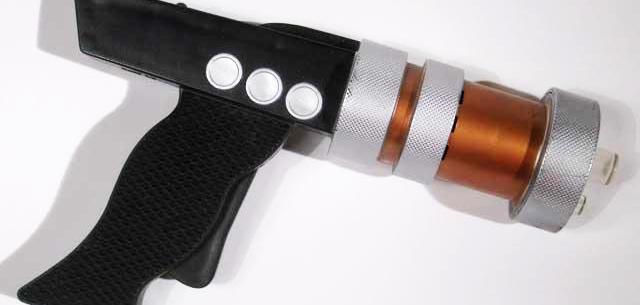
Review by Showapop
Of all of Star Trek, my favorite episode will always be the pilot episode The Cage and its subsequent series re-edit The Menagerie Part 1 & 2. Less Sci-fi Adventure and more Outer Limits, The Cage tells the story of the pre- Captain Kirk crew commanded by Captain Christopher Pike and the USS Enterprises visit to Talos IV, a mysterious planet with omnipotent aliens and survivors of an ill-fated space exploration mission. It really was a twisted and somewhat tragic episode and it stuck with me when I first watched it as a kid in the 1980’s.
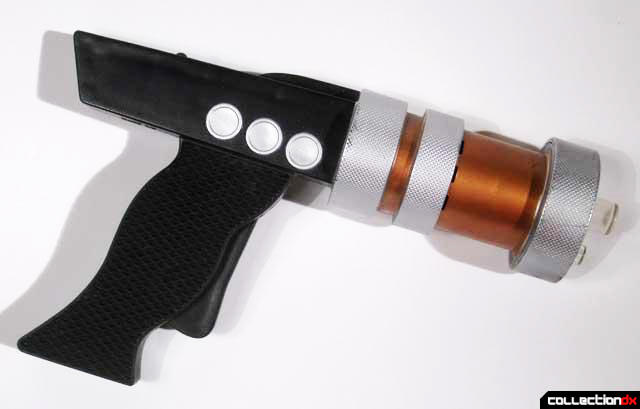
Not to waste footage, Desilu Productions subsequently reedited the pilot updated with the new Captain Kirk crew, with the plot concerning the mutiny of Mr. Spock and the now invalid Captain Pike with the USS Enterprise and their controversial return back to Talos IV. It was a cleverly edited episode that added a new dimension to Mr. Spock’s Character and its bittersweet ending also stuck with me when I watched it as a kid.

In the 1990’s Playmates acquired the Star Trek toy License and overall I believe they did an excellent job with the line, releasing many items that appealed to both kids and collectors alike, including this Captain Pikes Starfleet Laser Pistol. Unfortunately I was not collecting toys in the 1990’s and I was just content with admiring Star Trek toys in the toy aisles at Target and Toys R Us.

Fortunately my friend, Nathan Wilson from Rhino Records Claremont, knew I was a huge 1960’s Star Trek fan, especially of the more obscure Christopher Pike character, and picked up this Playmates Captain Pikes Starfleet Laser Pistol for me for Christmas. It was great to add this wonderful and unique Laser Pistol to my American Sci-fi collection.
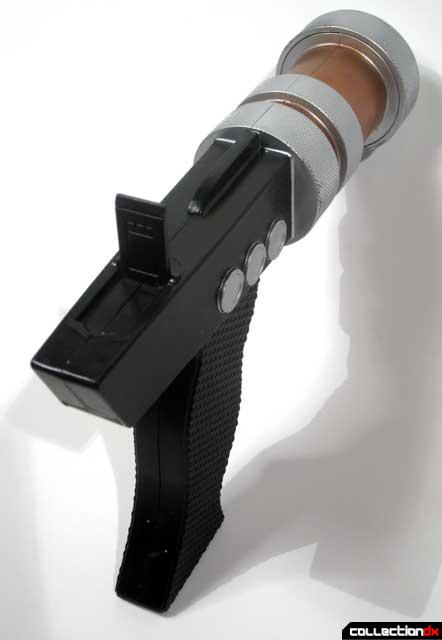
The second is a battery-operated light up tip and a dual sound effect. To change the sound effects just simply twisted the silver end of the pistol to either direction. Just pull the long trigger to activate the sounds and lights.
Solid enough for kid play but unique enough for serious Star Trek Collectors, Captain Pikes Starfleet Laser Pistol covers both groups very well. Although not as recognizable or iconic as the Star Trek Phaser, the Captain Pikes Starfleet Laser Pistol is a must own for the 1/1 scale Cospla Star Trek collection or if you are a fan of 1960’s retro Star Trek. Thanks again Nathan for hooking me up with this all those years ago.
©2013 Review and Pictures by Leonardo Flores and CollectionDX
Okay, that is just cool! I didn't know Playmates made one for the pilot episode though.
Still waiting for a toy version of the Assault Phaser from "ST-V" and "ST-VI"...

- Login or register to post comments
Thanks Eva,
I'm not sure if you noticed this in the Playmates Review Gallery as it has a few of your items in it. This is a really fun and obscure release and I had hoped you would personally like it!

Playmates getting Star Trek was one of the high points of the 90's. They produced so many great toys. I wish I had picked up more at the time, but I was just entering the job market. I still cherry pick a few here and there on Ebay.

Playmates 1990's Star Trek toys were one of the highlights of the era, I just wasn't into purchasing toys during those years ( I was in college and focusing on my Music back then) but I just enjoyed hitting up the toy aisles and I loved this line, especially when they released their TOS line. I was seriously tempted with buying them but I just didn't do it.
What I admire about Playmates and what I didn't realize until I wrote this review was they made great toys suitable for kids yet they were able to have enough coolness that adult collectors would enjoy. Very few toylines could pull that off but Playmates did for Star Trek fans both young and old. This pistol is a perfect example and glad I was finally able to give it its day in the sun here on CDX!
Thanks Japester!
Great review man. People sleep on the 90s Playmates stuff nowadays, and their props and ships are still awesome even compared to products made a decade later. Proof that new collector's toys aren't always better than previous releases. These look accurate (to my casual star trek eyes) and are kid-friendly and sturdy. You can put this phaser on a stand in a glass case to display, and then hand it off to a curious kid to play with, without worry of breaking.
I'll throw this out there though to those wondering why sometimes loose phasers and ships in this line go for more than mint in sealed box examples. The batteries leak and you've got to be careful buying boxed examples as you can't always see the damaged battery box through the package, you have to open them up to check. Again awesome review and I hope to see more classic Trek stuff on the site.

You make a great point. Luckily I took out the batterie while in storage and the pistol works just fine. Another great feature to note about this product is that the battery cover closes with a screw and will stay firmly with the pistol for a many years.
Use of this page constitutes agreement with our Terms of service
Privacy Policy
- YahooJapan Auctions
Federation Stardate: 40447.7

For all the Star Trek fans out there, here is a chance to own a piece of history. This 1997 Playmates Captain Pike's Starfleet Laser Pistol Collector's Edition is a must-have for any collector.
This vintage item is in excellent condition and is a rare find. It is an authentic replica of the original series phaser used in the show. The laser pistol comes with a series number of 0019030 and is suitable for ages 4+. Don't miss out on this opportunity to own a piece of science fiction history.
Playmates Star Trek Captain Pike's Starfleet Laser Pistol Collector's Edition
- Gameumentary
- Review in 3 Minutes
- Design Delve
- Extra Punctuation
- Zero Punctuation
- Area of Effect
- Escape the Law
- In the Frame
- New Narrative
- Out of Focus
- Slightly Something Else
- Privacy Policy
- Terms of Use
- Affiliate Policy
From Blasters to Phasers: How Close Are We to Laser Guns?
Laser guns have been the go-to staple for far-future science fiction for decades. Be they actual lasers or particle-beams that produce an energy pulse visual, they’ve rendered our movie and video game sci-fi battle scenes more seizure-inducing than a European night club. Directed Energy Weapons have been a focus of military research for some time, but just how close are we to actual, handheld laser guns, and how faithful will they be to their fictional portrayals?
The Phaser vs. The Blaster

The most common types of laser guns in fiction can be divided into two main categories, which we’ll call the phaser and the blaster – any aficionado of sci-fi knows where we’re going with this. Popular in older sci-fi, the phaser, as seen in Star Trek , fires an uninterrupted beam of light that strikes a target near-instantaneously. But the phaser-style of laser gun has fallen into disfavor in the last couple of decades, being replaced with the far more cinematic blaster, which fires a discrete package of “light” or illuminated matter that can be observed as a distinct projectile. Star Wars popularized the blaster, so much so that even the new Star Trek movies have adopted the visual style.
While the official canon of both Star Trek and Star Wars describe – in painstaking detail – the fictional mechanics of their respective weapons, we’re going to base ourselves simply on their most commonly observed characteristics and whether our current technology can replicate the results.
The Projectile
Guns fire bullets. Bazookas fire rockets. Laser guns fire… lasers, right?
That’s the idea, at least. The projectiles that issue from phasers and blasters have distinctly different qualities which form the core difference between these two weapons. We’ll call a phaser’s projectile a beam and the blaster’s projectile a bolt .

The difference between a beam and a bolt is presented most simply in First Person Shooters. Typically, futuristic FPS games such as Unreal Tournament feature weapons that can be divided into two groups: projectile and hitscan weapons. With a hitscan weapon, the moment you click “fire,” the computer calculates a straight-line path, and the nearest object that intersects that path is struck. A projectile weapon, on the other hand, fires an object that travels through the air at a given velocity and – if the game’s physics are good enough – has a ballistic trajectory.
The distinction between hitscan and projectile weapons in video games is effectively the same as that between beams and bolts, for our purposes. When you aim a laser pointer at someone, the beam strikes the target instantaneously – or at least, near-instantaneously, since even light has a velocity. Put simply: a beam cannot be dodged; a bolt can be dodged, if it is traveling slowly enough.
Projectile Speed

In both movies and video games, we find examples of humans dodging bolts without the aid of supernatural abilities or bionic augmentations. This arguably renders bolts inferior to beams and even bullets for most anti-personnel purposes, and calls into question the science behind the projectile.
If the projectile is a laser, then it is traveling at light speed and cannot be dodged. If the projectile is a stream of accelerated particles, which is the most common explanation for such weapons, then it is merely traveling at roughly 670 million miles per hour. Barring any form of Force powers or other magical hokum, it doesn’t matter how fast your reflexes are – you aren’t dodging that.
But maybe we want to argue that the bolts aren’t actually being dodged, that the characters are instead dodging before the trigger is pulled. Fine, but then how do we explain the visual depiction of a bolt flying across the movie screen?
Movies traditionally play at 24 frames per second, and in order for a viewer to determine the direction of a blaster bolt, that bolt must be visible in at least two consecutive frames: one frame to serve as a reference, the next to suggest the movement. Modern rifles have a muzzle velocity of more than 3,900 ft/s, meaning a bullet would travel 3,900 feet in 24 frames, or 163 feet per frame – that’s greater than the length of half a football field. Even a humble Beretta pistol has a muzzle velocity of 1,250 ft/s, or 52 feet per frame.
Add to that the fact that the human eye can only process 10 to 12 separate images per second and we realize that we would actually need a minimum of about 3-4 frames for the human eye to process the direction the bolt is traveling in. That means that by the time your eye can register the movement of a Beretta bullet, it has moved at least 100 feet. Most fight scenes don’t take place on such scales.
What about long corridors and perspective shots? Doesn’t that put that 100 feet figure into the realm of plausibility? If it were a glowing Beretta bullet, maybe. But we’re talking about accelerated particles traveling at almost one million ft/s, or over 7,500 miles per frame. That’s over twice the length of the continental United States.
The conclusion is obvious: not only would a realistic bolt be moving too fast to dodge, it would also be moving too fast to be seen .
Projectile Appearance and Noise
Now, there is one saving grace for the blaster. Modern militaries make use of tracer rounds, which are bullets that include a pyrotechnic charge that leaves a visible trail. If you watch footage of tracers in action, you’d swear you’re seeing a blaster bolt.
If we concede that a blaster bolt is something that cannot be dodged, and the visual effect is simply the trail left by some form of tracer that is perhaps even latent to the bolt itself, then we have redeemed the bolt into the realm of plausibility. However, the implication is that your target would be dead before you saw the bolt, which would simply be a “ghost” of the actual projectile.
What about laser beams? Shouldn’t lasers be invisible?
To answer that, we need to clarify what we are seeing when we “see” lasers. A laser consists of concentrated photons, or particles of light. We don’t “see” light; we see the physical objects that light illuminates. When you direct a laser pointer at a wall, you see a red dot on the wall because the beam of photons is being concentrated on that spot. Point the laser through fog, and you’ll be able to see some of the beam because the photons are illuminating the fog particles in its path.
Whether we “see” a laser beam or not depends on three factors. The first is the wavelength of light the laser emits – many military lasers used for tracking are in the infrared range, invisible to the human eye. Regardless of other factors, infrared and ultraviolet lasers are inherently invisible to us. Green lasers happen to be the most visible to us simply because our eyes are most sensitive to that wavelength of light. The second factor is the number of particles in the air the photons have to bounce off of – the greater the number of particles, the greater the visibility of the beam. Lastly, the strength of the laser also matters. Even in the absence of fog, a powerful enough green laser beam will be visible to us by reflecting off individual air molecules.
What this means is that a weapons-grade laser could either be visible or invisible; the decision is up to the designer. An invisible laser seems to be the perfect stealth weapon for a sniper, who can steadily aim through a scope from an incredible distance and not have to compensate for wind or ballistics. However, as a sidearm, having a visible laser may be beneficial to aiming.
But what about the noise? Would we hear the distinct pew pew popularized in fiction?
Likely not, but we would hear something . The machinery that operates high-powered lasers, their power source, and their cooling equipment, will make noise, generally a low humming or buzzing. Likewise, a particle accelerator would also generate similar noise as the magnets hum with electrical current.

When a modern gun is fired, there’s a strong kickback that, depending on the caliber of the round, can be powerful enough to injure an operator who isn’t properly wielding the weapon. In fiction, blasters have distinct recoil, whereas phasers do not. Would a laser gun have recoil?
Recoil is the result of one of the fundamental laws of physics: the conservation of momentum. Before you pull the trigger, the total momentum of the bullet and firearm, taken as a system, is zero. After pulling the trigger, the total must remain zero, so whatever momentum is imparted to the bullet speeding towards your target must be matched by the recoil of the gun pushing back against you. Momentum is a function of mass and velocity, so given two objects with equal momentum, the one that is more massive will be traveling slower – that’s why the gun doesn’t kill you through recoil.
In actuality, we need to consider the momentum of both the bullet and the gases escaping the barrel created by the explosive combustion, and it turns out that the gases impart more recoil on the gun than the bullet itself. That’s why suppressors reduce recoil significantly: they divert and trap the gases, releasing them slowly over a long period of time.
In the case of a laser, there is no explosion adding gases to the system. Further, the “projectile” being emitted is a stream of photons, which are massless. Lasers are powered by focusing the traveling direction of photons emitted from atoms. When we apply energy to an atom, it enters an “excited” state, and it returns to its normal state by releasing photons. A piece of red-hot metal glows because its atoms have been excited through heating and are releasing photons. While photons do exert some pressure – the concept of solar sails depends on this fact – that pressure is negligible for our purposes.
What about a particle-beam weapon? Again, it would not be powered by exploding gases. Particle accelerators use electromagnetic fields to send particles speeding along in a desired direction. There is some debate over whether or not this would produce appreciable recoil, but we’ll err on the side of “no recoil” for the following reasons. Firstly, there are no gases or other matter added to the system, which we’ve described to be a significant source of recoil in modern guns. Secondly, atomic and subatomic particles are so minuscule that even when accelerated to near-light speeds, their momentum is negligible. And lastly, electromagnetic fields violate Newton’s law of action and reaction and do not conventionally follow the principles of conservation of momentum, though an explanation as to why is beyond the scope of this article.

Prospective Real-Life Laser Guns
So we’ve concluded that an actual laser gun would have no appreciable recoil, wouldn’t emit a pew pew sound, would fire a projectile that may be invisible or unobservable, and cannot be dodged. Now, how close are we to having the technology to produce a practical, handheld laser gun?
Let’s take a look at our top prospects.
Actual Lasers
We already have surgical lasers that can cut through human flesh, manufacturing lasers that slice through steel, and military lasers undergoing R&D that can detonate enemy missiles midair. Why haven’t we already made a laser gun?
The problem largely lies in power consumption. A typical laser pointer uses 1-5 mW of power. A high-speed CD-RW burner uses 100 mW, 10 to 100 times that of a laser pointer. A surgical laser uses 30-100 W, up to 1000 times that of the burner. An industrial cutting laser could use up to 3000 W, 30 times that of the surgical laser. But for a laser to be classified as “weapons grade,” it needs to reach the 100 kW threshold, over 30 times that of an industrial cutting laser. That’s also the average power requirement of a couple dozen houses.
While we do presently have the technology to make such powerful lasers, both the laser device and the laser’s power source are massive . The Boeing YAL-1, now decommissioned, was basically a flying laser gun housed within a jumbo jet, and it was “only” a megawatt-class laser that required two minutes to burn a hole through an incoming enemy missile.
At this point, it’s just a matter of engineering and advances in miniaturization. If it seems hard to believe we’ll ever get laser weapons down to handheld size, just remember that the first computer weighed more than 60,000 lb, measured roughly 8 by 3 by 100 feet, and consumed 150 kW of power.
Electrolasers
Basically a long-distance Taser, the electrolaser comes very close to Star Trek ‘s phaser, complete with a stun setting. An electrolaser works by firing a non-deadly laser that rapidly heats and ionizes the air around it to form plasma, then sends an electric current down that plasma “channel” to the target.
Lightning works similarly. Though we don’t have a great understanding of how the air initially ionizes, the lightning bolt travels along an electrically-conductive plasma channel that consists of a soup of positively charged air molecules and the electrons that have been stripped from them. Since the 1970s, researchers have been trying to use lasers to trigger lightning strikes.
No electrolasers have yet been built, but the science is there. Successful tests in 2012 have shown that an electric discharge can travel along a laser beam, and weaponized applications are in development. We’re getting close to Unreal Tournament ‘s lightning gun.
Pulsed Energy Projectile
Formerly under development by the U.S. military, the PEP was a weapon intended for riot control. It worked by emitting an infrared laser pulse that, upon striking a target, vaporized enough molecules to create a small explosion of plasma. The resulting pressure wave could stun and knock down a person, and the released electromagnetic radiation had proven to cause pain and temporary paralysis in animal experiments.
The weapon weighed about 500 lb and would have been vehicle-mounted at the time that it was canceled in the mid 2000s. According to the Department of Defense, “The research finally concluded that the PEP laser could not reproduce the required waveform characteristic of a non-lethal weapon.”
While this is pure speculation, it is possible to interpret this to mean that the weapon caused damage to living beings, which would render it unusable for riot control purposes, and it was too cumbersome or fragile for battlefield deployment as a deadly weapon. Again, advances in miniaturization may one day lead to a revival of this technology as a portable, deadly gun.

Corporations have been funding research into weapons that fire plasma to cause severe burns, melting, and even death, though no practical examples have been produced. As with the case of laser guns, plasma guns would require more power than a handheld device can currently supply.
Even with a portable fusion reactor, though, plasma guns have other technological hurdles to overcome. Until some way is found to make a plasma beam self-sustaining over a longer period of time, it would be stopped by simple air resistance; the resulting gun would be similar to a blow torch. Generating a channel with a laser beam, as with the electrolaser, could be a way to circumvent this problem.
But nature herself seems to already have the solution: ball lightning, a phenomenon that we still don’t understand. One theory is that ball lightning is a spinning ring of plasma, which researchers have been able to reproduce in labs.
The plot thickens when we consider that a U.S. government research project called MARAUDER – an acronym for Magnetically Accelerated Ring to Achieve Ultra-high Directed Energy and Radiation – was successful in producing rings of plasma and balls of lightning that allegedly exploded with devastating effects upon striking a target. The project was first reported in 1993 and classified later that year. No further details about project MARAUDER have surfaced since.
Particle-Beam Weapons
Both Star Trek and Star Wars describe their phaser and blaster as particle-beam weapons that fire atomic or subatomic particles at near-light speeds, an idea founded in firm science. Imagine taking a particle accelerator like CERN’s Large Hadron Collider and weaponizing it.
A particle-beam weapon is similar in concept to a railgun, which uses electromagnetism to launch projectiles at hypersonic speed. Hurl a physical object at someone with enough speed and it’ll cause damage. Fire a stream of subatomic particles at near-light speeds and, given sufficient power and time, you can tear through virtually any physical material.
Again, a key problem lies in miniaturizing the technology. Ongoing research is seeking to apply military use to particle-beams, but we’re a long way off from handheld weapons.
Active Denial System

Finally, we arrive at our most promising lead. Also known as the Heat Ray, ADS is an actual nonlethal weapon developed by the U.S. military that was deployed in Afghanistan in 2010, but withdrawn before it saw combat. Mounted on a humvee, the weapon heats a target with microwaves that excite the water and fat molecules in the skin.
How effective is ADS? Most human test subjects reached their pain threshold within only three seconds of exposure, and none could endure more than five seconds. “For the first millisecond, it just felt like the skin was warming up,” said one of the test subjects. “Then it got warmer and warmer and you felt like it was on fire… As soon as you’re away from that beam your skin returns to normal and there is no pain.”
Both the U.S. Marines and police are working on portable versions of the Heat Ray. While a far cry from a flashy laser gun, this is the closest thing we have to a functional, practical, directed energy weapon.

- [ May 4, 2021 ] May the 4th: New Merchandise at Star Wars Shop Design
- [ April 1, 2021 ] Rick and Morty Get Shwifty Bluetooth Speaker Gadgets
- [ February 25, 2021 ] Harry Potter Wizarding World Nagini Mirror Design
- [ January 20, 2021 ] Star Wars The Mandalorian The Child Makeup Brush Holder Design
- [ January 6, 2021 ] Funko Pop! DC Comics Wonder Woman 1984 Golden Armor Vinyl Figure Design
Star Trek “The Cage” Laser Pistol Prop Replica
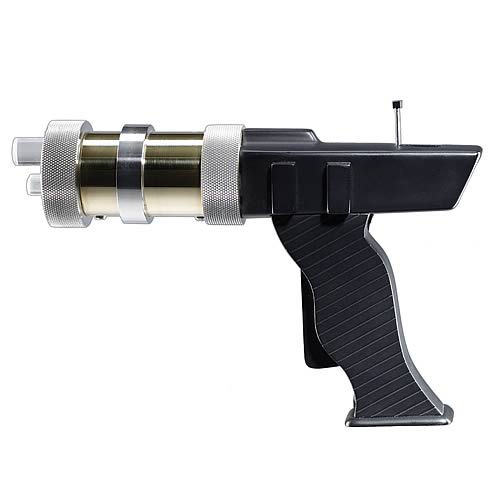
For the Star Trek collector that has to have it all and wants the very best, this Star Trek Cage Pistol Prop Replica could be your defining piece. The laser pistol was mastered from scratch using all available picture and episodic references by master prop maker Michael Moore of HMS Creative Productions. This is something you are going to want to show all your friends.
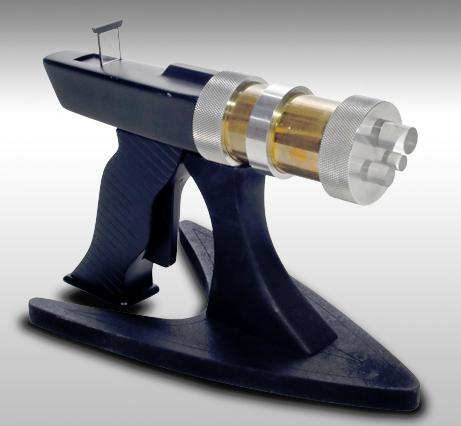
Details: ‘The Cage’ Laser Pistol notably appeared in the Star Trek pilot episode bearing the same name. This prop consists of a resin-cast main body along with machined brass & aluminum barrel parts, clear acrylic emitter tips, movable trigger, and rotating barrel ring. Features: Screen-accurate digital sound FX (Including firing sound & overload function) Pulsating Red LED light features with overload function Retractable Targeting Sight Exclusive Display Stand Certificate of Authenticity Batteries included Made in the U.S.A
The Star Trek “The Cage” Laser Pistol Prop Replica can be pre-ordered from entertainmentearth.com for $499.99 or it’s currently on back-order at roddenberry.com but was available for $499.95. If this is too pricey for your collection but you like nicely crafted Star Trek things, take a look at the Star Trek Hip Flask and Klingon Korkscrew .
Related Deals: Entertainment Earth Coupons
- Entertainment Earth
- Roddenberry.com
please let me know where i may buy the cage laser i went to entertainment earth could not find it went to roddenberry .com search result came back nothing found thank you in advance tony
This post is from 2011…not sure where you will find it now.
Leave a Reply Cancel reply
Your email address is optional. If provided it will not be published or shared.
Related Articles
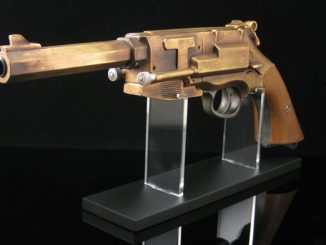

Firefly Serenity Malcolm Reynolds Pistol Prop Replica
Serenity now! We all want more since Firefly was cancelled well before its time. Well, we may not be able to watch new episodes, but you can get all nostalgic with this Firefly Serenity Malcolm Reynolds Pistol Prop Replica. It’s an exact replica of the […]

Nicolas Cage Adventure Set
Nothing to plug in. No batteries to replace. Tons of fun whether you love the guy or hate him. The Nicolas Cage Adventure Set is just one of those sources of entertainment that you can’t go wrong with. It even has a hint of nostalgia […]
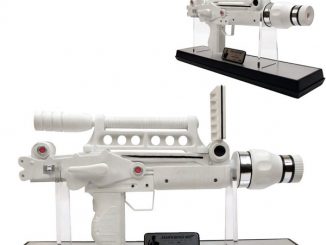
James Bond Moonraker Laser Gun Replica
Moonraker is one of the more Sci-Fi James Bond movies. And this James Bond Moonraker Laser Gun Replica can be had by you to always remember the film. It is made of high-quality polyresin and is a limited edition of just 500 pieces. As far […]
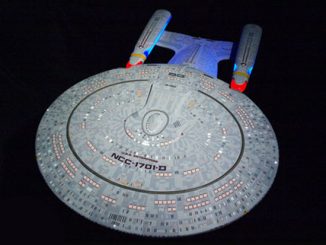
Star Trek: The Next Generation Enterprise D Artisan Replica
If you named the cat Spock and always tell your kids they have the conn when you leave the room then you are an ultimate Star Trek fan, and the ultimate fan needs the ultimate starship. The Star Trek: The Next Generation Enterprise D Artisan […]

The Hobbit: Thorin’s Key to Erebor Prop Replica
If you love The Hobbit and want a truly unique collectible on your shelf, you might consider this The Hobbit: Thorin’s Key to Erebor Prop Replica. It’s the secret key to the backdoor entrance of Lonely Mountain and the Dwarf kingdom. And it can be […]

Star Trek Starfleet Badge Prop Replicas
Only the best of the best are accepted into Starfleet and given the honor to wear the badge. With these Star Trek Starfleet Badge Prop Replicas, you can wear exact uniform insignia replicas from the Star Trek XI movie to show your affiliate with Starfleet […]
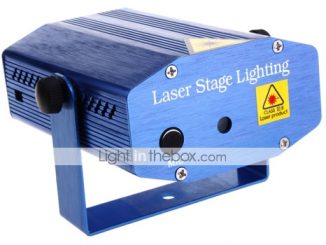
Laser Light Show Special Effects Stage Projector
Turn an ordinary room into party central with this Laser Light Show Special Effects Stage Projector. There have been other laser light show projectors like the Disco Laser Mini Projector, Pocket Laser Light Show, and Disco Laser Pointer, but with the powerful red and green […]
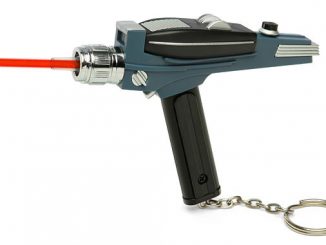
Star Trek TOS Phaser Laser Pointer
Set your phasers to awesome. This Star Trek TOS Phaser Laser Pointer is perfect for putting some Star Trek flair into your corporate presentation. This tiny prop replica has amazing details. It even has a built-in keychain so you can take it everywhere. Star Trek […]
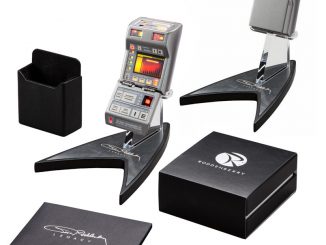
Star Trek Starfleet TR-590 Mark IX Science Tricorder Replica
The Tricorder is one the most well-known sci-fi accessories and now you can own a beautiful replica of the device. The Star Trek Starfleet TR-590 Mark IX Science Tricorder Replica is a full 1:1 scale prop replica with screen-accurate sound effects. It features a wearable […]

Laser Projector with Pac-Man Animations
This new home projector uses green laser to project animated animated cartoons, like Pac-Man, a walking cat, a dancing girl, elephants and more, onto your wall.
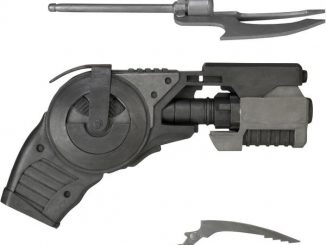
Arkham Origins Prop Replica: Grapnel Gun and Accessories
Fans of the grim, no-nonsense world of the action-adventure game Batman: Arkham Origins will want to get their hands on the Arkham Origins Prop Replica: Grapnel Gun and Accessories so they can be properly equipped while imagining themselves as the Dark Knight during his early […]
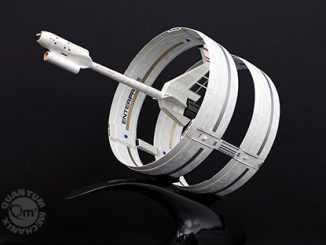
Limited Edition Star Trek Enterprise Ring Ship Artisan Replica
Even the greatest starship in the Federation’s fleet had to start somewhere and the Very Limited-Edition Star Trek Enterprise Ring Ship Artisan Replica reveals the humble beginnings of the ship that would eventually be commanded by Captain James T. Kirk. This highly-detailed replica is for […]
© 2007 - 2020 GeekAlerts. All Rights Reserved.
- Skip to navigation (Press Enter)
- Skip to main content (Press Enter)
Star Trek: The Original Series, TOS- laser pistol from "The Cage"
Replica movie prop weapon.
This is a TOS "The Cage" laser pistol made by playmates. It features lights and two different sounds. The sounds are switched by twisting one of the silver dials on the copper barrel. The playmates version seems to combine elements fron the mark I version in "The Cage" and the mark II version featured in "Where No Man Has Gone Before." For example, the three silver buttons on the side of the playmates version where not on the mark I version only the mark II. However, the mark II version had two large silver wheels/dials on the back of the pistol that weren't on the mark I.
- Скидки дня
- Справка и помощь
- Адрес доставки Идет загрузка... Ошибка: повторите попытку ОК
- Продажи
- Список отслеживания Развернуть список отслеживаемых товаров Идет загрузка... Войдите в систему , чтобы просмотреть свои сведения о пользователе
- Краткий обзор
- Недавно просмотренные
- Ставки/предложения
- Список отслеживания
- История покупок
- Купить опять
- Объявления о товарах
- Сохраненные запросы поиска
- Сохраненные продавцы
- Сообщения
- Уведомление
- Развернуть корзину Идет загрузка... Произошла ошибка. Чтобы узнать подробнее, посмотрите корзину.
Original Star Trek
- Contact Form
- Privacy Policies
- Service Agreement
Star Trek Pilot Episode’The Cage’ Captain Pikes Laser Pistol

- Featured Person/Artist: Captain Pike Laser Pistol
- Character Family: Star Trek
- Type: Action Figure
- Brand: Playmates Toys
- Character: Phaser, Laser Pistol
- Theme: Star Trek (Original TV Series)
- TV Show: Star Trek: The Original Series
- Packaging: Original (Opened)
Recent Posts
- Star Trek Tridemensional Chess Set Franklin Mint Complete
- Obsession Star Trek The Original Series Reaction Season 2
- William Shatner Star Trek (TV Show) TV Miscellaneous Memorabilia
- Star Trek Prototype Phaser The Wrath of Khan 1982 inspired Prop
- Genuine authentic telosian head bust from star trek
- February 2024
- January 2024
- December 2023
- November 2023
- October 2023
- September 2023
- August 2023
- February 2023
- January 2023
- December 2022
- November 2022
- October 2022
- September 2022
- August 2022
- February 2022
- January 2022
- December 2021
- November 2021
- October 2021
- September 2021
- August 2021
- February 2021
- January 2021
- December 2020
- November 2020
- October 2020
- September 2020
- August 2020
- February 2020
- January 2020
- December 2019
- November 2019
- October 2019
- September 2019
- August 2019
- February 2019
- January 2019
- animaniacs-star
- autographed
- autographed'star
- christopher
- collectable
- commercials
- communicator
- complicated
- consecutive
- d'echecs
- enterprise-nx01
- hirschfeld's
- metamorphosis
- micromachin
- orig'67
- pfaltzgraff
- rittenhouse
- rockesteady
- shatnernimoy
- spockleonard
- supplemental
- three-dimensional
- unforgettable
- unpublished
- untershshirt
- vintage1994
One of the “Best Worst” ‘Star Trek’ Episodes Recreates the Gunfight at the O.K. Corral
Join the Enterprise in an adventure to Tombstone, Arizona.
The Big Picture
- An outlandish storyline tests the crew's limits in Star Trek: The Original Series when Melkotians send Kirk and crew to O.K. Corral, Old West.
- Spock's mind meld convinces the crew that bullets are illusions, saving them in the gunfight.
- Kirk's refusal to kill during the shootout impresses the Melkotians, leading to Federation unity.
Many television shows have filler episodes or episodes that just don't land with audiences. It happens to the best of them. Friends, Gilmore Girls , Charmed , and Supernatural all have episodes that didn't rate well with their substantial audiences. Even shows with a massive following, like Star Trek , have episodes that have silly plots with a hint of something fascinating hidden within them. Honestly, with plots that are so far-fetched, people love them and continue to come back to them over and over again. The Season 3 episode of Star Trek: The Original Series , entitled "Spectre of the Gun," is noted as one of Star Trek's best worst episodes, which depicts the famous gunfight at O.K. Corral .
Even the toughest episodes have little gems fans are always searching for. In a franchise with a huge cult following, like Star Trek, people often discuss episodes and why they love them or can't stand them. Fans will always find something to enjoy, whether it is an idea within the storyline, a character arc, or a performance by one of the actors. And that's why it's called the best worst episode. With a cast of such iconic characters like Spock , Bones, Kirk, and Uhura, it's hard not to find something to love about the episodes.
Star Trek: The Original Series
In the 23rd Century, Captain James T. Kirk and the crew of the U.S.S. Enterprise explore the galaxy and defend the United Federation of Planets.
What Happens In 'Spectre Of The Gun'?
In this infamous episode of The Original Series , the USS Enterprise heads into Melkot space. They're greeted by one of the Melkotians who tells them to leave and never return, and that will be their only warning . But of course, being Starfleet, the crew will do anything to prove they come in peace. The starship gets to the planet where Captain Kirk ( William Shatner ) , Spock ( Leonard Nimoy ), Dr. McCoy ( DeForest Kelley ), and Chekov ( Walter Koenig ) go on an away mission to befriend the Melkotians. Things don't go as planned when the Melkotians send the crew to the Old West—specifically, Tombstone, Arizona, on October 26, 1881, on the historical day at O.K. Corral. The crew assumes that the violence of Kirk's heritage is to be the pattern for their execution. Like the historical event, it is the Earps versus the Clantons and McLaurys -the Starfleet officers represent the latter two families- as they duke it out for O.K. Corral via gunfight. However, in not wanting to participate in a shootout, Kirk does everything in his power to convince everyone around him that he isn't one of the Clantons.
Still, no one believes in his wild tale. So, Spock and Bones decide to make some alternate weapons to aid in their advantage because in the original O.K. Corral shootout, the Earps win, and the crew doesn't think the story can be altered. Little do they know that it can be changed. Unfortunately, they find out after Chokov is shot and killed when, in real life, his persona is the only one that survives. They also figure out any devices they create won't work, and if they try to avoid the gunfight, they'll just be transported to the spot. That's when they put the pieces together. Spock says that "where the laws do not operate, there is no reality," meaning that nothing is real; if they don't believe the bullets are real, they can't be killed. Spock also speculates that it was Chekov's mind that killed him, not the bullets. He believed the bullets would kill him, so they did. But how can they go into the shootout with absolute certainty that the bullets won't kill them? The answer is simple. They can't without the help of a mind meld from Spock. So, that's what they do. Spock convinces them with ultimate certainty that nothing is real. Nothing happens to them when they're in the midst of the shootout; then, they get into an all-out brawl before the Melkotians tell Kirk to kill them. Kirk refuses, and the Melkotians see that Starfleet might not be so bad after all. In fact, they are impressed and want to unite with the Federation.
Hidden Gems In One Of The Best Worst Episodes
The outlandish storyline makes you question why—after Kirk and crew intrude into Melkot space—if the Melkotians are so powerful, why don't they smite them where they stand instead of sending them to the O.K. Corral in the Old West? They could have so easily obliterated the Enterprise if they didn't want to make contact at all. However, it was a good idea if they wanted to test the crew. It seems like an outlandish kind of test, but what can you expect? Everyone thinks differently.
But the episode also has some fascinating nuggets, like when Spock's mind melds with everyone to make them believe the bullets of the Earp gang are nothing but an illusion with absolute certainty. This gives the crew members no fear when dealing with the Earps, whereas before, Bones was convinced there was no way they would be able to get through the fight with absolute certainty. Bones is usually the most skeptical with Spock, but he has no problems doing the mind meld, which saves their hides in the end.
Another excellent example of fascination in one of the best and worst episodes is how Kirk and the crew finally get through to the Melkotians by showing they won't kill for revenge , no matter how much they're pressured into it. Just when you thought Kirk might break and kill the Earp brother, he doesn't. Spock even comments on it later on. Kirk responds by saying humans have evolved past the need for violence , which is hopefully the case 100 years in the future. The Melkotians appreciated the gesture and became friends with the Federation.
It's also interesting to note that the budget for this episode was lower than usual. Walter Koenig reminisced that the network had been spending too much money , as seen in the half-built Old West sets, which perfectly fit in with the storyline. Koenig loved the episode for what it gave his character : he gets the girl, dies, and comes back to life all in one episode. Chekov doesn't get the girl often but makes it work in this episode as he soaks up every moment of being fawned over and having someone to fawn over.
Star Trek: The Original Series is streaming on Pluto TV in the U.S.
WATCH ON PLUTO TV
U.S. Military Is Using Laser Weapons In Battle
Prototype laser air defense systems deployed by the U.S. Army have taken out enemy drones in the Middle East, an Army official told Forbes.
- Share to Facebook
- Share to Twitter
- Share to Linkedin
BlueHalo's Locust laser air defense system, which is designed to shoot down small drones, rockets and mortar shells.
T he United States military has invested tens of billions of dollars over a half-century in the research and development of directed energy weapons. Now, it’s actually using them in battle.
The Army has used lasers to take down hostile drones in the Middle East, Doug Bush, the Army’s head of acquisitions, recently told Forbes . It’s the first time the Defense Department has acknowledged that such weapons have been used in combat.
“They've worked in some cases,” Bush said. “In the right conditions they're highly effective against certain threats.”
He declined to detail the weapons used, but one appears to be a system called P-HEL. It’s based on the defense contractor BlueHalo’s Locust laser, a boxy pallet-mounted device for fixed-site defense that’s commanded with an Xbox gaming controller. The weapon is designed to discharge a relatively low-powered 20-kilowatt laser beam that melts a critical point on a drone in seconds, knocking it from the sky.
In November 2022, the Army began using the first P-HEL overseas, with a second unit deployed this year, according to BlueHalo , making it the first “major laser weapon system” to be operationally deployed, CEO Jonathan Moneymaker told Forbes . But it has never before confirmed its use in battle.
Moneymaker said Locust has had a “significant” number of successful engagements in which it has burned drones out of the sky. “Not in the onesies, twosies,” he said.
It’s a milestone for the Pentagon, which is wrangling the costs of unmanned aerial combat, where the price of defense often far exceeds that of offense. U.S. air defense missiles cost roughly twice as much as offensive missiles, and the disparity is even worse with the cheap drones that have proliferated in the Middle East and in the Russia-Ukraine war. In the Red Sea, U.S. warships defending cargo vessels from attacks by Yemen’s Houthi militants over the past six months have used $2 million missiles to shoot down $2,000 drones.
So-called directed energy weapons like lasers and high-powered microwave systems, which use electromagnetic radiation to fry the electric components of their targets, are vastly cheaper. Their cost per shot ranges between $1 to $10 for the diesel fuel needed to generate the electricity that powers them, according to a 2023 GAO report.
Another benefit of laser weapons: stealth. The beams are usually invisible and silent. Advocates of an effort to test a laser on an Air Force special operations AC-130 gunship touted the prospect of being able to disable vehicle engines and communications equipment without an enemy knowing. (The program was canceled this spring after years of delays.)
Small drones are an easier target for the nascent technology compared to missiles and manned warplanes since they’re relatively slow and fly at low altitudes.
But laser weapon systems are expensive to build. The first P-HEL prototypes cost $8 million apiece, the Army told Forbes ; prototypes of a vehicle-mounted system with a more powerful 50-KW laser called DE M-SHORAD have cost $73 million. That’s a pricey investment given the many expensive modernization programs competing for the Pentagon’s $825 billion budget.
“It's really tough for the Army to afford a directed energy system that costs as much as an F-35,” said Bush, who hopes prices will drop to a fourth of the stealth fighter jet’s average $82.5 million price tag.
The current generation of laser prototypes also face questions about their effectiveness. Lasers are hampered by sandstorms, rain, fog and smoke. Even on a clear day, air turbulence can defocus and weaken them. And they need to remain focused on a point on a target for several seconds, raising questions over whether a single laser can deal with swarms of drones.
But advocates say laser counter-drone systems don’t have to work in all conditions to be worthwhile.
Bad weather also degrades the effectiveness of the weapons that they’re meant to counter, notes Thomas Karr, who was the inaugural director of a Pentagon office set up to coordinate directed energy research from 2018 to 2020. “The incoming drone isn't going to fly very well in a sandstorm either.”
Bush said lasers would just be one part of a multi-layered counter-UAS system including kinetic interceptors like missiles or RTX’s Coyote kamikaze drone ($120,000 a pop) and gun-based weapons like C-RAM.
“If it saved 10% to 20% of the interceptors we would have to otherwise fire, that's still a very good return on investment,” he said.
Star Wars Dreams
The promise of directed energy weapons has enticed the Pentagon since the 1960s, but it was thwarted for decades in part by overambitious projects like the Reagan-era Space Defense Initiative. Derided as Star Wars, until its cancelation in 1993, roughly $30 billion was spent to develop a system that included space-based lasers to blow up fast-moving Soviet ballistic missiles from thousands of miles away.
Another prominent failed attempt to blast ICBMs: the $5 billion Airborne Laser program, billed as America’s first lightsaber, which was wound down in 2012. Researchers struggled with size and weight problems in mounting a megawatt-class laser powered by bulky containers of hazardous chemicals on a 747 airliner.
By 2010, research had refocused on the much less ambitious goal of hitting smaller targets like artillery shells and the emerging threat of slow-moving drones from just a couple of miles away or less.
“The technology does not have to perform at this very stressing level and you don't need as much power, you don't need as much accuracy,” said Karr.
The Pentagon has been spending roughly a billion dollars a year on directed energy research since 2020, according to a GAO report.
“In the low 20s” number of systems have been deployed with military units for field testing and are available for commanders to use, said Frank Peterkin, the DoD’s principal director for directed energy.
That includes four DE M-SHORADs, which feature a laser made by RTX mounted on a Stryker armored troop carrier. They were deployed to Iraq this spring for field testing. (One focus is on how well the lasers stand up to the shock and vibration as they’re moved around.)
Members of the 60th Air Defense Artillery Regiment pose with Stryker armored vehicles outfitted with 50-KW lasers at Fort Sill, Oklahoma, after the prototype systems were delivered in September.
Since 2019 the Navy has installed a low-powered laser “dazzler” called ODIN on eight destroyers; it’s designed to disrupt the optical or infrared sensors on enemy drones. In 2022 the Navy fielded a 60-KW laser made by Lockheed Martin Lockheed Martin called HELIOS on another destroyer, the Preble, that’s capable of destroying drones and outboard motors on small boats.
But these weapons have been notably absent from the fighting in the Red Sea, where they could be effective against some Houthi weapons, Vice Admiral Brendan McLane, the head of naval surface forces, said in January . He called the slow pace of progress in fielding laser weapons “frustrating.”
High-powered microwave weapons aren’t hampered by weather, but they tend to have a shorter range. The Southern California startup Epirus will soon deliver the final two of four prototypes of its Leonidas system ordered by the Army under a $66 million contract. Epirus CEO Any Lowery told Forbes it can throw up “a wall” of energy hundreds of yards out from a base’s perimeter to take down multiple drones simultaneously, functioning as the last line in a layered air defense, like a “hockey goalie.”
It would take six of the systems to defend an average airfield, Lowery said. The four prototypes have cost $13 million apiece, Army said.
Lowery says Leonidas performed better than he expected in Army trials last month at the China Lake weapons range in California. They included tests of soldiers’ abilities to quickly repair the system, as well as defeating attacks by a range of drones.
Epirus' Leonidas high-powered microwave counter-UAS system.
Lowery is hopeful that Leonidas will advance soon to an overseas field deployment and that by 2027 Epirus could win the holy grail for weapons makers: transition to a “program of record” with a budget line for buying Leonidas units in large numbers.
That could track with the Army's timeline on directed energy weapons. Bush said the service is currently preparing budget plans for the 2026-30 timeframe in which they’re examining “how we could actually get to procurement on these things.”
Meanwhile, the DoD is funding work on more powerful lasers, including 300-KW systems from companies including Lockheed Martin, General Atomics and nLight that could take on larger, faster targets like cruise missiles. DoD directed energy czar Peterkin said the hope is that those will be ready for testing with field units within five years.
The U.S. is also investing in an intriguing Israeli effort. The military aid package for Israel that Congress passed last month includes $1.2 billion to fund development of Iron Beam. The 100-KW laser from Israeli defense contractor Rafael is designed to defeat rockets and drones. Israel hopes to field it by the end of next year, and the Pentagon could be interested in it as an alternative to the systems it’s developing, Bush told reporters last year.
If the Pentagon decides to field any of the current laser prototypes at scale, it could take a while for defense contractors to build up to mass manufacturing. Only a handful of companies make key components like optics, the Emerging Technologies Institute, a defense industry association think tank, warned in January . It faulted the Defense Department for having “wavered in its commitment” to the technology and failing to send a clear demand signal to industry to invest to get ready.
Bush said it’s more a question of limited congressional funding and multiple pressing priorities.
“Everything’s competing with everything else,” said Bush. “But what could move the dial is the threat is serious. And if we show that these systems can work against the current threats we're facing in the Middle East, it could move the conversation in the Pentagon.”

- Editorial Standards
- Reprints & Permissions

IMAGES
VIDEO
COMMENTS
A laser pistol, or hand laser, was a directed-energy weapon utilized by the Klingon Empire and the United Federation of Planets. (TOS: "The Cage", "A Private Little War") The pistols used by Starfleet in the 2250s and 2260s were designed with multiple power settings. ... In Star Trek, the crew of the USS Kelvin were equipped with phaser pistols ...
Shop for gifts. You can have your own laser pistol like Captain Pike had in the original ST:TOS pilot episode, The Cage, with a red (<5 mW) laser! This started out as the 1997 Playmates #16127, but now instead of a little light bulb youll have to replace, it has a red laser! It still uses 2 AA batteries.
Just pull the long trigger to activate the sounds and lights. Solid enough for kid play but unique enough for serious Star Trek Collectors, Captain Pikes Starfleet Laser Pistol covers both groups very well. Although not as recognizable or iconic as the Star Trek Phaser, the Captain Pikes Starfleet Laser Pistol is a must own for the 1/1 scale ...
For all the Star Trek fans out there, here is a chance to own a piece of history. This 1997 Playmates Captain Pike's Starfleet Laser Pistol Collector's Edition is a must-have for any collector. This vintage item is in excellent condition and is a rare find. It is an authentic replica of the original series phaser used in the show. The laser pistol comes with a series number of 0019030 and is ...
Lasers are a sidearm in the original Star Trek pilot "The Cage", and laser pistols appear in several Star Trek: The Original Series (TOS) episodes, ... They are the 22nd century precursor to phaser technology, in addition to phase pistols (hand-carried phase cannons). Unlike 24th century phasers, they do not have the normal variable power ...
Star Trek Captain Pike's Starfleet Laser Pistol. By Playmates, 1997. Excellent condition. Unusual item. Playmates made nice replicas of Star Trek accessories. Item # 16127-Laser Pistol as seen in the classic Star Trek Episode " The Cage".
Captain Pike's Starfleet Laser Pistol Star Trek 1997 Playmates 16127 New In Box. Brand New. 3.5 out of 5 stars. (3) 3 product ratings. C $132.68. or Best Offer. from United States. Vintage Playmates 1997 - STAR TREK - Captain Pike's Starfleet Laser Pistol - NIB. Pre-Owned. C $108.33.
I took a Playmates Star Trek Federation Laser Pistol, gutted it, and installed a 150mw laser emitter and hooked it to the trigger. Now I can lights matches ...
Popular in older sci-fi, the phaser, as seen in Star Trek, fires an uninterrupted beam of light that strikes a target near-instantaneously. But the phaser-style of laser gun has fallen into ...
From Wiki on Star Trek Phaser: Originally (from the production notes to TOS), the Phaser was a PHoton mASER, since at the time of writing the Laser was a relative unknown, and powers were not expected to be very great. Masers, on the other hand, were already very powerful machines which produce very destructive radiation pulses.
Get the best deals on star trek phaser pistol when you shop the largest online selection at eBay.com. Free shipping on many items | Browse your favorite brands | affordable prices. ... Star Trek Original Series Playmates Captain Pike Starfleet Laser Pistol Sealed. $30.00. or Best Offer. $9.00 shipping. Star Trek - 40th Anniversary Phaser Pistol ...
This is a second edition (#2 of 10) Starfleet Laser Pistol built by Steve Dymszo at SD Studios. Pistol grip/body molded off Greg Jein's authentic filming laser from the original 1964 Star Trek pilot episode "The Cage." Other measurements from Greg Jein's laser were incorporated into the machined components of this laser. A beautiful reproduction!
New. Sealed Star Trek 1997 Playmates Captain Pike's Starfleet Laser Pistol vintage. Never opened. Never used. No Store stickers on box. Clean. The original "try me" batteries are obviously dead as this is from 1997. Each laser was individually numbered. The number on this is 39,880.
In this, STAR TREK's first pilot, the crew of the Enterprise employ a laser cannon in a deserperate bid to save Captain Pike! Now remastered to 4K/48fps, fr...
The Star Trek "The Cage" Laser Pistol Prop Replica can be pre-ordered from entertainmentearth.com for $499.99 or it's currently on back-order at roddenberry.com but was available for $499.95. If this is too pricey for your collection but you like nicely crafted Star Trek things, take a look at the Star Trek Hip Flask and Klingon Korkscrew ...
animals gifts for girls toy dollhouses. 1997 Star Trek Captain Pikes Starfleet Laser Pistol The perfect gift for any Trekkie fan. The Starfleet laser pistol as seen in the classic Star Trek pilot episode, The Cage. Removed from box to remove factory installed batteries and to test (see video, unfortunately Etsy video does not support.
Star Trek: The Original Series, TOS- laser pistol from "The Cage" replica movie prop weapon . This is a TOS "The Cage" laser pistol made by playmates. It features lights and two different sounds. The sounds are switched by twisting one of the silver dials on the copper barrel. The playmates version seems to combine elements fron the mark I ...
STAR TREK LASER PISTOL the CAGE 1997 PHASER Prop Painted As Picture Shows. $24.99. or Best Offer. $6.75 shipping. 25 watching. Sponsored Sponsored Ad. Star Trek "Original" Phaser Pistol prop KIT cos Play needs assembly ! $19.90. $7.15 shipping. 292 sold. Sponsored Sponsored Ad.
Star Trek Pilot Episode'The Cage' - Captain Pikes Laser Pistol. Box opened to take photos, Box does have some fraying due to age. This item is in the category "Toys & Games\Action Figures & Accessories\Action Figures". The seller is "michaele8″ and is located in this country: GB. This item can be shipped to United Kingdom.
The Season 3 episode of Star Trek: The Original Series, entitled "Spectre of the Gun," is noted as one of Star Trek's best worst episodes, which depicts the famous gunfight at O.K. Corral . Even ...
T he United States military has invested tens of billions of dollars over a half-century in the research and development of directed energy weapons. Now, it's actually using them in battle. The ...